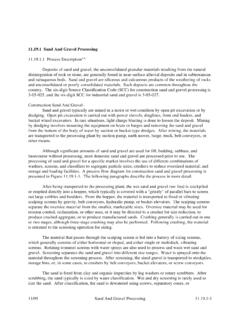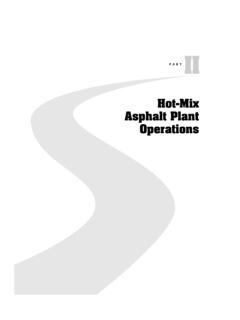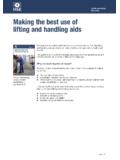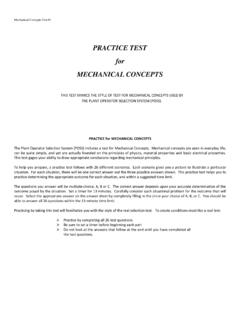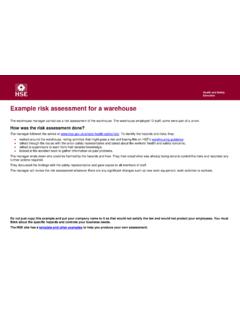Transcription of Chap. 8 Friction - 國立臺灣大學
1 Chap. 8 Friction8-1-2 Chapter OutlineCharacteristics of Dry FrictionProblems Involving Dry FrictionWedgesFrictional Forces on ScrewsFrictional Forces on Flat BeltsFrictional Forces on Collar Bearings, Pivot Bearings, and DisksFrictional Forces on Journal BearingsRolling Resistance8-1-3 APPLICATIONSIn designing a brake system for a bicycle, car, or any other vehicle, it is important to understand the frictional forces involved. For an applied force on the brake pads, how can we determine the magnitude and direction of the resulting Friction force?8-1-4 APPLICATIONS (continued)Consider pushing a box as shown here. How can you determine if it will slide, tilt, or stay in static equilibrium?
2 What physical factors affect the answer to this question?8-1-5 CHARACTERISTICS OF DRY Friction (Section ) Friction is defined as a force of resistance acting on a body which prevents or retards slipping of the body relative to a second show that frictional forces act tangent (parallel) to the contacting surface in a direction opposing the relative motion or tendency for the body shown in the figure to be in equilibrium, the following must be true: F = P, N = W, and Wx = OF Friction (continued)To study the characteristics of the Friction force F, let us assume that tipping does not occur ( , h is small or a is large). Then we gradually increase the magnitude of the force P.
3 Typically, experiments show that the Friction force F varies with P, as shown in the left figure CHARACERISTICS (continued)The maximum Friction force is attained just before the block begins to move (a situation that is called impending motion ). The value of the force is found using Fs = s N, where s is called the coefficient of static Friction . The value of s depends on the materials in the block begins to move, the frictional force typically drops and is given by Fk = k N. The value of k (coefficient of kinetic Friction ) is less than s . k are typically 25% smaller than s on on on on on iceCoefficient of Static Friction sContact Materials8-1-9 DETERMING s EXPERIMENTALLYA block with weight w is placed on an inclined plane.
4 The plane is slowly tilted until the block just begins to inclination, s , is noted. Analysis of the block just before it begins to move gives (using Fs = s N): + Fy = N W cos s = 0+ FX = S N W sin s = 0 Using these two equations, we get s = (W sin s ) / (W cos s ) = tan s This simple experiment allows us to find the S between two materials in FOR ANALYSIS (Section )Steps for solving equilibrium problems involving dry Friction :1. Draw the necessary free body diagrams. Make sure that you show the Friction force in the correct direction (it always opposes the motion or impending motion).2. Determine the number of unknowns. Do not assume F = S N unless the impending motion condition is Apply the equations of equilibrium and appropriate frictional equations to solve for the TIPPING versus SLIPPINGFor a given W and h, how can we determine if the block will slide first or tip first?
5 In this case, we have four unknowns (F, N, x, and P) and only three , we have to make an assumption to give us another equation. Then we can solve for the unknowns using the three EofE. Finally, we need to check if our assumption was TIPPING versus SLIPPING (continued)Assume: Slipping occursKnown: F = s NSolve: x, P, and NCheck: 0 x b/2 OrAssume: Tipping occursKnown: x = b/2 Solve: P, N, and FCheck: F s N8-1-13 Characteristics of Dry FrictionAngle of Friction )(tan1sNFS = SSNN 11 ==tan)(tan )(tan1kNFk = kkNN 11 ==tan)(tanKS 8-1-14 Characteristics of Dry FrictionAngle of Repose SSSWFWN sincos==)cos(SSSWN ==SS 1tan = = 8-1-15 Problems Involving Dry FrictionEquilibrium Impending Motion at All Points 8-1-16 Problems Involving Dry FrictionTipping or Impending Motion at Some PointswxPh=ImpendingMotion)(2/0 NFbxS = Tippingx=b/2)(NFS wPhx= p x h P F couple x Pwxh=2bx=maxhh= 8-1-17 Example uniform crate has a mass of 20kg.
6 If a force P = 80N is applied on to the crate, determine if it remains in equilibrium. The coefficient of static Friction is = normal force NC act a distance x from the crate s center line in order to counteract the tipping effect caused by unknowns to be determined by 3 equations of , )() (30cos80) (30sin80; ;0030cos80;0236 = ===+ = = + = += = +=ooooSolution8-1-20 Since x is negative, the resultant force acts (slightly) to the left of the crate s center tipping will occur since x frictional force which can be developed at the surface of contact Fmax = s NC = (236N) = 401, 8-8 The uniform pole has a weight of 150 N and a length of m. Determine the maximum distance d it can be placed from the smooth wall and not slip.
7 The coefficient of static Friction between the floor and the pole is s= 403, 8-15 The spool has a mass of 200 kg and rests against the wall and on the floor. If the coefficient of static Friction at B is ( s )B = , the coefficient of kinetic Friction is ( K )B = , and the wall is smooth, determine the Friction force developed at B when the vertical force applied to the cable is P = 800 405, 8-28 Determine the minimum force P needed to push the two 75-kg cylinders up the incline. The force acts parallel to the plane and the coefficients of static Friction of the contacting surfaces are A = , B = , , and C = Each cylinder has a radius of 150 408, 8-45 The 45-kg disk rests on the surface for which the coefficient of static Friction is A = Determine the largest couple moment M that can be applied to the bar without causing 410, 8-60 If =15 , determine the minimum coefficient of static Friction between the collars A and B and the rod required for the system to remain in equilibrium, regardless of the weight of cylinder D.
8 Links AC and BC have negligible weight and are connected together at C by a ( ) P=0 Block(A) self-locking8-2-2 Screws An inclined plane or wedge wrapped around a cylinder lead l, lead angle rsLPM = =8-2-3 Screws RSWrPLrMS,,== , Problem 8-72 The wedge blocks are used to hold the specimen in a tension testing machine. Determine the largest design angle of the wedges so that the specimen will not slip regardless of the applied load. The coefficients of static Friction are A = at A and B = at B. Neglect the weight of the , Problem 8-84 The clamp provides pressure from several directions on the edges of the board. If the square-threaded screw has a lead of 3 mm, mean radius of 10 mm, and the coefficient of static Friction is S = , determine the horizontal force developed on the board at A and the vertical forces developed at B and C if a torque of M = N m is applied to the handle to tighten it further.
9 The blocks at B and C are pin connected to the Belts)..(..sinsin)(:).(..cos)(cos:202201 0220= + = =+ += dTddTTdNFddTTdNdTFyX12cos,22sin,02sin dddddT eTTTTdTdTdTdTTddNdTdNTT = = = = = = 121202121ln)()( (radian) , 8-92. The boat has a weight of 2500 N ( 250 kg) and is held in position off the side of a ship by the spars at A and B. A man having a weight of 650 N ( 65 kg) gets in the boat, wraps a rope around an overhead boom at C, and ties it to the end of the boat as shown. If the boat is disconnected from the spars, determine the minimum number of half turns the rope must make around the boom so that the boat can be safely lowered into the water at constant velocity.
10 Also, what is the normal force between the boat and the man? The coefficient of kinetic Friction between the rope and the boom is s = Hint: The problem requires that the normal force between the man s feet and the boat be as small as , 8-108. Determine the maximum number of 25-kg packages that can be placed on the belt without causing the belt to slip at the drive wheel A which is rotating with a constant angular velocity. Wheel B is free to rotate. Also, find the corresponding torsional moment M that must be supplied to wheel A. The conveyor belt is pre-tensioned with the 1500-N horizontal force. The coefficient of kinetic Friction between the belt and platform P is K = , and the coefficient of static Friction between the belt and the rim of each wheel is s = and Disks = = = = = = === = 2122313220221222021222122212232002121 RRRRPM ddrrRRPrdrdRRPrMrdFMMrdrddAdARRPpdAdNdFR RPpSRRSRRSAZSSS )()(])([:)()(PRMS 320= ==12RR,R : bearing pivot For8-2-13 Journal Bearings fkrr= sinfkkkkkkkkZRrRrMRrMrRMM == =+ = sintansin0)sin(:0 8-2-14 Rolling Resistance arWaPWarPWa Pr)cos( , 8-102.

